Global Health Software
The following is some software that was developed or applied to supporting global health projects in countries such as the Philippines, Malawi, Zambia and Kenya.
The motivation for these applications was to develop software that improved the efficiency for preforming a specific task. A prime example is reporting on healthcare data. Many projects and organizations are collecting an ever increasing amount of data, however, have difficulties in analyzing and reporting on that data. It is not an issue about having more data analysts or statisticians on the project, but more of an issue that the right kind of software applications have not been developed to automate the manual process that is so time consuming.
Developing software for Global Health has several advantages. The first is that the projects are in resource limited environments. Therefore, efficiency should be a high priority. The second is that the infrastructure and previous-experience with other systems is lacking — which allows for more innovative solution to be implemented. Finally, working in Global Health you can often gain a new perspective due to the user community not having previous experience with other kind of systems.
WebReports
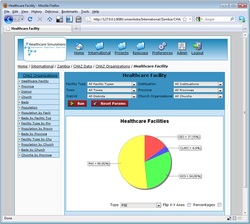
WebReports is a web-based reporting system that was designed for rapid deployment. When traveling to developing countries there is often limited time – so the approach was to create a system that could easily take any database and quickly deploy a interactive web-based reporting system.
At the core of WebReports (also known as Medical Informatics Technical Analysis System – MITAS) is a philosophy of accomplishing the task as soon as possible. For example, instead of a web-based reporting system taking months to deploy, WebReports is typically deployed in 2-3 days.
WebReports has been used on projects in Malawi, Zambia, Kenya, Philippines and at the World Health Organization head quarters in Geneva.
WebReports has the following capabilities:
- Dynamic High-Level Charts (pie, bar, line, scatter, radar)
- Dynamic Filters
- Dashboards
- Gantt Charts
- Integration with Google Maps
- Static Network Graphs
- Dynamic network Graphs (Space Tree, Radial Tree and Hyper Tree)
- Literature Repository
- Integration with R (www.r-project.org)
- R Code Library Repository
- PDF printing
- Automated Emailing of Reports (with day offset)
- Query on Demand for user-derived reports
Future development ideas include:
- Natural Language Interface
- Clinical Fact Database
- Addition of AMPL for Optimization utilizing Grid Computing
- Addition of Grid Computing for Weka and R
Active Development: 2006-2010
Multi-Touch for Health (MT4Health)
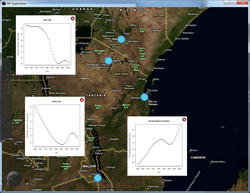
MT4Health is an project that combined health care statistical graphs with multi-touch technology for displaying global health care information on a country by country perspective. Open data from the World Bank and World Health Organization was used to automatically create health care statistical graphs and embed them in a multi-touch application. We utilized mt4j.org as the framework and Flickr.com for the graph repository and R 2.11 for the generation of the charts. A Dell ST220T (21″) monitor was used for the testing.
Active Development: 2011
Global Surveillance and Emergency Response System (GuSERS)
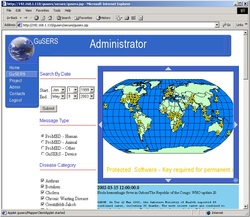
The GuSERS system was a project that looked at the issue of reporting in real-time from environments that had no working power or telecommunication systems. The system involved using a commercial low-bandwidth satellite two-way pager combined with a solar power tickle charger (developed) for remote communications. A web-based map (geographical information system) server was developed (in 2003) for managing and displaying the information. Initial information was also supplemented through ProMed by an automatic email parser. The GuSERS system was tested in Laos, Malawi and Zambia. Abstracts (posters) were published for this project.
Active Development: 2001-2005
Infectious Disease Emergency Simulation System (IDESS)
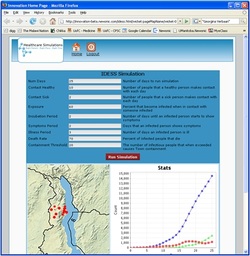
The IDESS system was developed to automatically create a multi-agent simulation for simulating an infectious disease outbreak from existing GIS data. The concept with IDESS was if a simulation system could be developed in a manner of hours to aid in the first few days of a crisis. The IDESS system would take existing GIS information and create a network graph from all the towns/cities intersecting with the road GIS information. The Agent based simulation would then run on top of this network graph. Results from the simulation were then saved to a database where WebReports would then be used to analyze the simulations. Several papers in Multi-Agent journals were published.
Active Development: 2006
Nursing Staff Simulation System for Malawi and Zambia
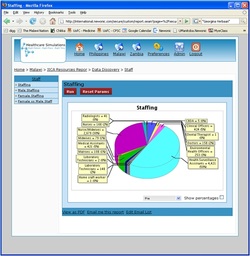
This was a program that created a multi agent simulation system from a healthcare facility database. The database used was the JICA healthcare facility survey. Every hospital in the country was included in the modeled and every nurse was represented. In addition, nursing schools were added to the model to provide a source of new nurses into the system. Parameters were then used to describe how the nurses interacted with the system, such as moving, retirement, etc. A major component of the model was the poaching agents. These were agents that would recruit nurses away from the healthcare facilities such as international recruitment firms. All results from the simulation(s) were stored to a database where WebReports was then used for the trending and analysis. A book chapter was published on the approach and methodology.
Active Development: 2007
Zamboanga, Philippines Census Application
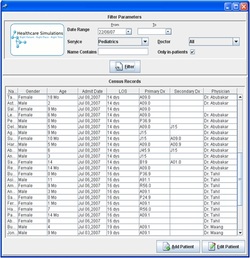
The Census application was used in the Pediatrics Ward of the Zamboanga General Hospital. This program introduced electronic data collection to the Pediatrics Ward. A key part of the project was to see what would happen when a reporting system was implemented at the same time as the production data collection system. The belief was that data quality would improve by having near real-time reporting. Three programs/approaches were used in this project.
a) The first approach was to collect the data using Microsoft Access. The database would then be transferred using Patient-X to a web-server in Canada running WebReports that would then do the reporting and analysis.
b) The second phase was a thick java client that replaced the Microsoft Access database. The data was stored on the server in Canada where the WebReports software continued to do the reporting. An important finding of this approach was having to deal with multiple time zones as the data collected on the thick client side would have a different time zone from the server where the data was stored.
c) The third approach was a complete web-based solution that did both the data collection and the data reporting and analysis. Nothing has been published on this project.
Active Development: 2006-2008
Zamboanga, Philippines Literature Repository
This project was to create an online literature repository of the various thesis’s that were produced at the Ateneo de Zamboanga University Medical School. This project took a unique view as the literature repository was embedded with the reporting system used in the Zamboanga General Hospital Pediatrics Ward. The philosophy being that the literature should exist where the data was. Nothing was published on this project.
Active Development: 2007
Family and Reproductive Health Project (Malawi and Zambia)
This was a project through CPHA (Canadian Public Health Association) funded through CIDA working in collaboration with Malawi and Zambia Partners. The partner in Malawi was the UNDP. The partners in Zambia were with Planned Parenthood Association of Zambia (PPAZ) and Churches Health Association of Zambia (CHAZ). This project included development and deployment of a data capture system for the projects in both Malawi and Zambia. This system was written in Microsoft Access and reporting utilized the WebReports system.
Active Development: 2003-2005





